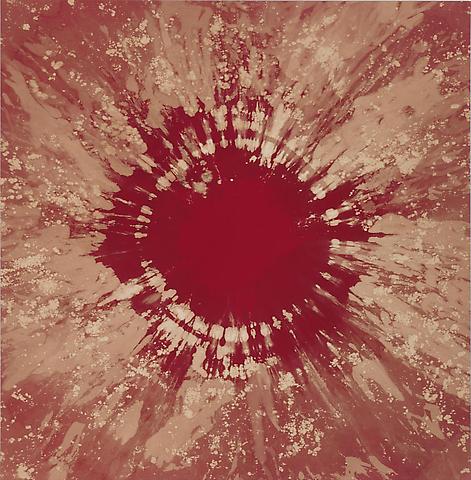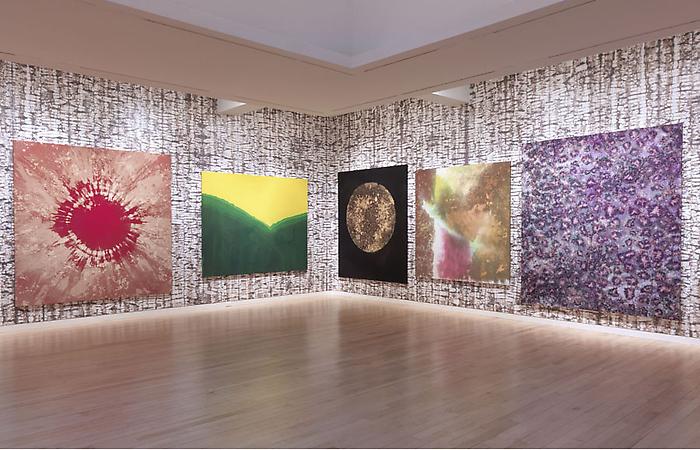In the main gallery of Discharge!, Piotr Uklański’s current show at Gagosian Gallery, fourteen vibrantly colored large-scale paintings hang unusually close together on walls covered in equally dynamic wallpaper. The overall effect is striking, and stepping into the room is to step into a dense and immersive visual experience (the press release describes the exhibition as “a mise-en-scène of new paintings”). Uklański’s abstract panels are not your typical oil paintings, but commercially sourced cotton bedsheets stretched over canvas. To produce his kaledescopic surfaces, the Polish-born artist saturates the store-bought sheets with fiber-reactive dyes, which he then carefully removes—or discharges—using bleach and other agents to create complex surface patterns and effects.
While Uklański’s methods and results certainly call to mind the tie-dyeing commonly associated with a 1960s counter culture aesthetic, his panels suggest other antecedents as well, especially the gestural and chromatic abstraction that prevailed in New York in the 1950s. The broad expanses of color in Uklański’s Sous le Soleil, for example, evoke the luminous fields of a Helen Frankenthaler stain painting, or perhaps a spare yet serene seascape by Milton Avery. The frenetic splatters and centrifugal energy of Uklański’s Untitled (Orgasmatron) or Untitled (Tropical Floral) conjure the vigorously applied pigment and restless movement of a Jackson Pollock canvas.

Piotr Uklański, "Untitled (Orgasmatron)," 2010. Fiber-active dye on oxidized cotton textile stretched over cotton canvas, 95 3/4 x 94 inches. Courtesy Gagosian Gallery
Aside from summoning forth Abstract Expressionism and the psychedelic, tie-dyed aesthetics of the 1960s, Uklański’s surfaces also suggest a range of biological and cosmological forms. The dense matrix of cellular structures in New Age, for example, reads as a strangely familiar image of some organic microstructure, while the incandescent surfaces of Yukon Sky and Once Upon a Time evoke the indeterminate expanse of a primordial universe. And these are not the only allusions in Uklański’s panels, as the show is teeming with references to the desiring body and the private space of the bedroom, most notably in the double entendre of the exhibition’s title, the ubiquity of bedsheets stained with fluid spatters, and in the sexual, at times erotic titles of some of the paintings (including Atomic Ovum, Orgasmic, and Kinda Kinky).
Some critics have deemed Uklański’s bedsheet paintings to be somewhat insubstantial—as glib postmodern parodies of modernism and as performing what is by now a trite collapsing of high and low art forms. While this criticism may or may not be warranted, the works in Discharge! are simply beautiful to behold, and their dizzying cascade of references and allusions makes the gallery space seem more a mise-en-abyme of visual signifiers than merely a mise-en-scène of tie-dyed panels. Uklański’s nebulous surfaces and primordial imagery evoke a sense of the sublime while simultaneously invoking an art historical past that in many ways sought to do the same. What is more, by using his discharge method of dye removal to produce abstractions reminiscent of Abstract Expressionism and Color Field painting, Uklański’s bedsheets reveal a connective tissue between the otherwise divergent aims of mid-century abstraction and the more psychedelic aesthetic of the 1960s: the imaging of (the now clichéd) utopian ideals and the imagining of unencumbered bodies, both individual and social.

Piotr Uklański, "Jupiter Glow," 2010. Fiber-active dye on oxidized cotton textile stretched over cotton canvas, 61 3/8 x 75 inches. Courtesy Gagosian Gallery
Perhaps this is in part the point of Uklański’s new works: not, or not simply to revel in clichés and disclose them as such, but to liberate and reinvigorate the overdetermined visual signifiers of modernist abstraction and the counter-culture of the 1960s, and to do so through the use of materials sourced from the consumer culture that has rendered them so banal (the bedsheets are from IKEA and Bloomingdales). Uklański has suggested that his immigrant status in a country where Abstract Expressionism and the modern hippie movement were born has allowed him a certain distance from their well-worn meanings and assumptions, perhaps offering him an alternative perspective on those pictorial traditions: “Neither English nor abstraction is my mother tongue,” he said with regards to this current show, adding that the paintings “‘speak’ an aesthetic ESL [English as a Second Language].” This matter-of-fact proclamation of his being at a remove from, or an outsider to—temporally, spatially, geographically—the formal and historical legacies of abstraction seems particularly striking for its lack of compunction. He doesn’t seem particularly burdened by his belatedness to it, nor is he preoccupied with achieving fluency in it. Rather than reading Uklański’s bedsheet paintings as parodies of past art movements and current consumer culture—their formal beauty and complexity resist such an easy conclusion—could we not read them as liberatory artistic discharges freed from a temporal burden (the art historical past) and a spatial one (the commodified art culture of the present) and which instead intend to just be—be conceptually rigorous, be sublimely beautiful, be cheekily irreverent? In short, Uklański’s bedsheet paintings can “speak” whatever we choose to glean from their labyrinth of references.
To this point, the exhibition’s title—Discharge!— can be taken a number of ways. Aside from being a term used to describe the process of bleaching out colors in dying and printing textiles, it also has sexual connotations quite befitting the libidinal undertones of the show. But there is another definition of “discharge” that seems in keeping with the spirit of the exhibition as I see it, which is the meaning of “discharge” as “to relieve oneself of a burden or responsibility.” And it is this last meaning that seems particularly apposite to Uklański’s abstract panels.
Piotr Uklański’s Discharge! is on view through February 19, 2011 at Gagosian Gallery (Madison Avenue, NYC).





Pingback: Piotr Uklański’s “Discharge!” « Refining Your Art Practice